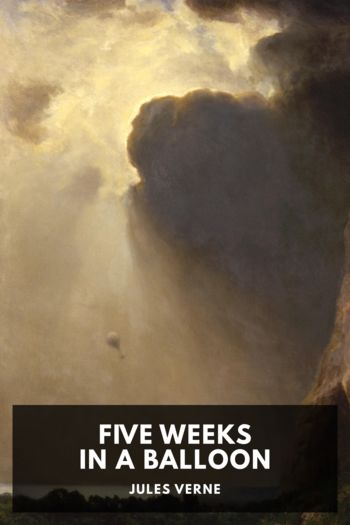From the Earth to the Moon, Jules Verne [beach books .TXT] 📗

- Author: Jules Verne
Book online «From the Earth to the Moon, Jules Verne [beach books .TXT] 📗». Author Jules Verne
This being resolved upon, the work was begun. According to the calculations of the Cambridge Observatory staff, the tube of the new reflector was to be 280 feet long and its mirror 16 feet in diameter. Although it was so colossal it was not comparable to the telescope 10,000 feet long which the astronomer Hooke proposed to construct some years ago. Nevertheless the setting up of such an apparatus presented great difficulties.
The question of its site was promptly settled. It must be upon a high mountain, and high mountains are not numerous in the States.
In fact, the orographical system of this great country only contains two chains of average height, amongst which flows the magnificent Mississippi, which the Americans would call the “king of rivers” if they admitted any royalty whatever.
On the east rise the Apalachians, the very highest point of which, in New Hampshire, does not exceed the very moderate altitude of 5,600 feet.
On the west are, however, the Rocky Mountains, that immense chain which begins at the Straits of Magellan, follows the west coast of South America under the name of the Andes or Cordilleras, crosses the Isthmus of Panama, and runs up the whole of North America to the very shores of the Polar Sea.
These mountains are not very high, and the Alps or Himalayas would look down upon them with disdain. In fact, their highest summit is only 10,701 feet high, whilst Mont Blanc is 14,439, and the highest summit of the Himalayas is 26,776 feet above the level of the sea.
But as the Gun Club wished that its telescope, as well as the Columbiad, should be set up in the States of the Union, they were obliged to be content with the Rocky Mountains, and all the necessary material was sent to the summit of Long’s Peak in the territory of Missouri.
Neither pen nor language could relate the difficulties of every kind that the American engineers had to overcome, and the prodigies of audacity and skill that they accomplished. Enormous stones, massive pieces of wrought-iron, heavy corner-clamps, and huge portions of cylinder had to be raised with an object-glass, weighing nearly 30,000 lbs., above the line of perpetual snow for more than 10,000 feet in height, after crossing desert prairies, impenetrable forests, fearful rapids far from all centres of population, and in the midst of savage regions in which every detail of life becomes an insoluble problem, and, nevertheless, American genius triumphed over all these obstacles. Less than a year after beginning the works in the last days of the month of September, the gigantic reflector rose in the air to a height of 280 feet. It was hung from an enormous iron scaffolding; an ingenious arrangement allowed it to be easily moved towards every point of the sky, and to follow the stars from one horizon to the other during their journey across space.
It had cost more than 400,000 dollars. The first time it was pointed at the moon the observers felt both curious and uneasy. What would they discover in the field of this telescope which magnified objects 48,000 times? Populations, flocks of lunar animals, towns, lakes, and oceans? No, nothing that science was not already acquainted with, and upon all points of her disc the volcanic nature of the moon could be determined with absolute precision.
But the telescope of the Rocky Mountains, before being used by the Gun Club, rendered immense services to astronomy. Thanks to its power of penetration, the depths of the sky were explored to their utmost limits, the apparent diameter of a great number of stars could be rigorously measured, and Mr. Clarke, of the Cambridge staff, resolved the Crab nebula in Taurus, which Lord Rosse’s reflector had never been able to do.
Final DetailsIt was the 22nd of November. The supreme departure was to take place ten days later. One operation still remained to bring it to a happy termination, a delicate and perilous operation exacting infinite precautions, and against the success of which Captain Nicholl had laid his third bet. It was, in fact, nothing less than the loading of the gun and the introduction into it of 400,000 lbs. of guncotton. Nicholl had thought, not without reason, perhaps, that the handling of so large a quantity of pyroxyle would cause grave catastrophes, and that in any case this eminently explosive mass would ignite of itself under the pressure of the projectile.
There were also grave dangers increased by the carelessness of the Americans, who, during the Federal war, used to load their cannon cigar in mouth. But Barbicane had set his heart on succeeding, and did not mean to founder in port; he therefore chose his best workmen, made them work under his superintendence, and by dint of prudence and precautions he managed to put all the chances of success on his side.
First he took care not to bring all his charge at once to the inclosure of Stony Hill. He had it brought little by little carefully packed in sealed cases. The 400,000 lbs. of pyroxyle had been divided into packets of 500 lbs., which made 800 large cartridges made carefully by the cleverest artisans of Pensacola. Each case contained ten, and they arrived one after the other by the railroad of Tampa Town; by that means there were never more than 500 lbs. of pyroxyle at once in the inclosure. As soon as it arrived each case was unloaded by workmen walking barefoot, and each cartridge transported to the orifice of the Columbiad, into which they lowered them by means of cranes worked by the men. Every steam engine had been excluded, and the least fires extinguished for two miles round. Even in November it was necessary to preserve this guncotton from the ardour of the sun. So they worked at night





Comments (0)